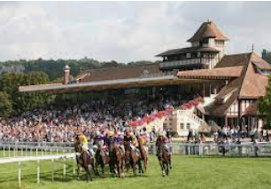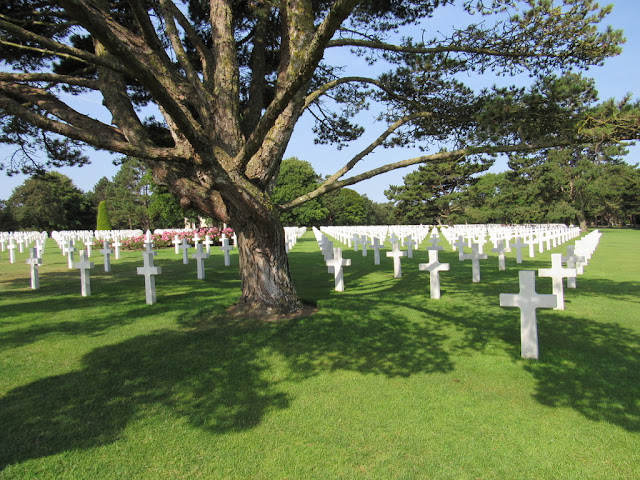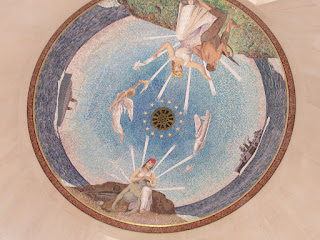Deauville, the "Little Cannes", the "Queen of Normandy Beaches", the "Kingdom of Elegance," is a thriving town on the Côte Fleurie that runs along the coast of the Atlantic Ocean--and one of the most prestigious seaside resorts in all of France. Since the 19th century, Deauville has been a fashionable holiday destination for both the international upper class and wealthy families. It is also known for its art such as Proust's In Search of Lost Time, Boudin's Impressionist paintings, and Coco Chanel's career as a fashion designer.
Deauville is considered an "oo-la-la" kind of place, a very posh playground that attracts the upper classes, wealthy entrepreneurs, and movie stars. Among its amenities are pricey hotels, a casino, boutiques, fancy restaurants, a hippodrome for horse racing, two world class golf courses, the American and the Asian Film Festivals, sea baths and sea therapy spas, and, of course, the beach and its famous boardwalk, Promenade des Planches.
Deauville started out as a simple dream of hospitality. Charles de Mornay, the Duke of Mornay, wanted a special place to entertain his wealthy friends. He then got the idea to establish a vacation spot for French gentry to enjoy the good life.
Actually, Mornay set the groundwork for the leisure industry, which was developed here during the Belle Epoque (1871-1914) by Eugene Cornuché who established the Normandy Hotel (1912), Casino (1912), and the Hotel Royal (1913). A bronze bust of Cornuché (1867-1926) stands along the walkway near the harbor.

During World War I (1914-18), Deauville turned its big hotels into hospitals for wounded Allied soldiers. After the war, Deauville further expanded with a new train station and the iconic Art Deco bathing facilities and the Promenade des Planches boardwalk.
The Germans enjoyed Deauville's villas,
hotels, and the casino during World War II (1939-45). However, following the liberation of France on D-Day, they were pushed out. After the war, German prisoners worked to clear the beaches of barbed wire they had previously placed there.
Photo: US National Archives.
In
the 1960s, Deauville capitalized on its reputation for myth and
exclusivity and rebuilt itself to become a draw again for the wealthy and high society celebrities from
almost every field. Marinas
were added beside the Touques estuary, and the Deauville American Film
Festival, inaugurated in 1975, began drawing stars and fans of the
silver screen every September. Scenes of Deauville in award-winning films like
Claude Lelouch's "Un Homme et Une Femme") renewed its status as a chic
resort town of Europe. The Asian Film Festival also held here began in 1999. The former swamp had become an international phenomenon.

The Normandy Hotel (through a bus window, sorry)

The Casino
The beach is a big draw for the crowds--even in stifling 100-degree heat.
It was not evident whether the people were day trippers or guests from
the hotels, but they were clearly enjoying the water and sandy beach.

The changing rooms at the beach are named after famous movie stars who had been coming to Deauville for decades. The art deco bathhouses are highlighted by concrete and mosaic Pompeian baths.
The famous 2100-foot long Promenade des Planches designed in 1921 by French
architect Charles Adda is made from wood from
Madagascar.


One of the cultural issues that is currently playing out in France is Muslim beachwear for women. In order to show their modesty, the women have "swim dresses" or at least some kind of covering. The few examples I saw on the beach were in black. Websites dedicated to Muslim swimwear modify the concept and present more colorful alternatives. Click here for a sample.
Deauville
is internationally known for its horse culture, its famous
tracks, Yearling sales, and its annual races. Two
famous race tracks are Deauville la Touques and Clairefontaine.
Deauville also hosts polo tournaments, horse shows, and the European
championship of miniature horses. This area is the main horse breeding
region in France and home to numerous stud farms.
Deauville has some beautiful houses, and here are a few samples.



Trouville

Across the Touques River is Trouville, which is supposed to be a more family-oriented place with more reasonable prices.
Trouville honors one of Deauville's important vacationers, Coco Chanel, with a square (right) and a plaque in her name. She spent time here during her affair with Boy Capel. He helped finance a shop that allowed her to move from hat making to clothing and clothing design. Inspired by the beach and sea, Chanel created a new style for women that included nautical themes, use of the color beige, and "le petit robe noir" (little black dress). Click here to see some of her early designs.

 Eugène Boudin (1824-98), an Impressionist painter, made Deauville the subject of many of his paintings. Boudin was
one of the first French landscape painters to paint outdoors. (Here he is at his easel in Deauville.) Boudin was
a marine
painter, and expert in the rendering of all that goes upon the sea and
along its shores. He usually divided his canvas
into two parts: 2/3 sky and 1/3 land, so Corot dubbed him "the king of the skies".
Eugène Boudin (1824-98), an Impressionist painter, made Deauville the subject of many of his paintings. Boudin was
one of the first French landscape painters to paint outdoors. (Here he is at his easel in Deauville.) Boudin was
a marine
painter, and expert in the rendering of all that goes upon the sea and
along its shores. He usually divided his canvas
into two parts: 2/3 sky and 1/3 land, so Corot dubbed him "the king of the skies".
He was born at Honfleur, the son of a harbor pilot. At age 10 he worked on a steamboat that ran between Le Havre and Honfleur. He painted many pictures of Honfleur as well. Click here for a selection of his art.
Resources
Pololine -- https://www.pololine.com/articles/deauville-history-and-culture-of-an-elite-destination/
D-Day Overlord -- https://www.dday-overlord.com/en/battle-of-normandy/cities/deauville












































